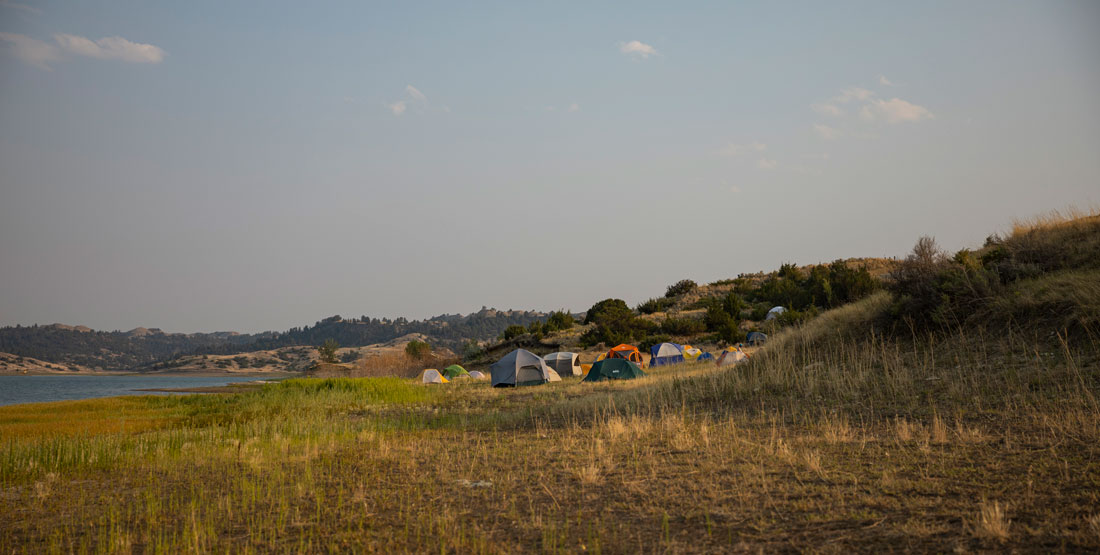Hell Creek site
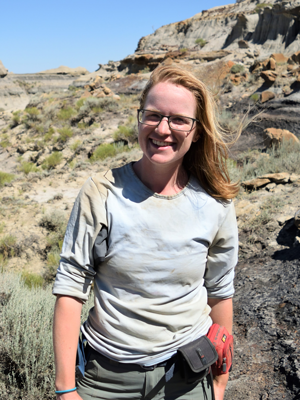 Paige Wilson Deibel (she/her)
Paige Wilson Deibel (she/her)
Burke Museum Paleobotany Collections and Lab Manager, University of Washington
My research investigates the impact of mass extinction events on the diversity and ecology of plant communities. As the Paleobotany Collections Manager, though, I also oversee >70k plant fossils in our collection which span over 400 million years of Earth history and come from across the globe!
This will be my sixth DIG Field School in Montana. I think my favorite memory of fieldwork in the Hell Creek area was visiting one of our plant fossil sites across the lake from camp. You get to start off your morning with a boat ride across the lake watching the sun rise, hike across rugged hills to a peak where you are offered 360-degree views of the badlands, and the fossils we find at that site are beautiful!
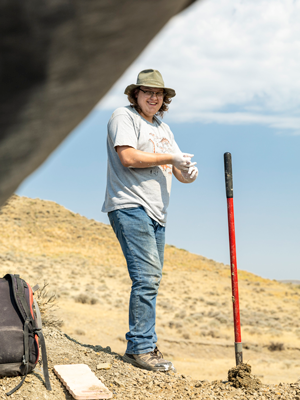 Ezekiel (Zeke) Augustine (he/him)
Ezekiel (Zeke) Augustine (he/him)
General Biology major, University of Washington
I am interested in researching theropod dinosaurs, which is the group that includes Hell Creek’s Tyrannosaurus rex. For my current undergraduate project, I am analyzing the teeth of theropod dinosaurs collected by the Wilson-Mantilla Lab to see if I can find any changes in this group that could help to explain why birds were the only dinosaurs to survive the mass extinction at the end of the Cretaceous.
Picking a favorite moment from my two previous years of field season experience with the Wilson Mantilla Lab is hard, but the DIG Field School stands out as the highlight of both seasons. Not only is it a blast to get to help K-12 educators gain hands-on experience with paleontology, but I love having the opportunity to connect to and learn from them as well!
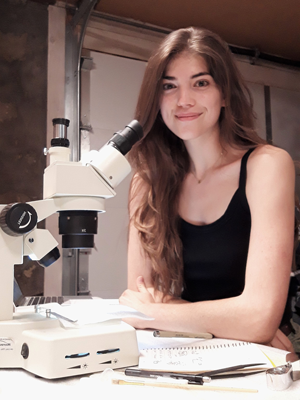 Kirsten Meltesen
Kirsten Meltesen
Biology PhD student, University of Washington
I study mammal communities from the mid-Paleocene, several million years after the mass extinction that wiped out the dinosaurs. At this time, mammals were highly diverse, but many species around back then have since died out, leaving behind no modern relatives. I'm interested in reconstructing the ecological relationships between these archaic species to determine whether ancient mammal communities were similar in structure to modern ones.
This will be my second DIG Field School in Montana. My favorite part of the DIG is when we learn about microfossil collection and screenwashing. Finding miniscule fossils among a sea of pebbles and dirt is incredibly challenging, but when you find one, it feels like you've won the lottery! I'll never forget the first fossil I found doing fieldwork myself.
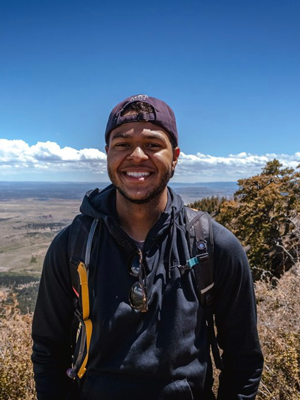 Isiah Newbins
Isiah Newbins
Biology PhD student, University of Washington
I study mammals from the Late Cretaceous, approximately 84–72 million years ago (Ma), long before the extinction of the dinosaurs. In fact, the time period I study, the Campanian, is the peak of dinosaur diversity in North America! The mammals from this period are unlike any around today. Early mammals, like the multituberculates, show diversity in their already exciting morphology and the early marsupials of the time show little resemblance to their modern descendants. So how is it that these small mammals were able to diversify even with this huge ecological pressure imposed by the dinosaurs? Well, we aren't exactly sure, but I'm hoping that I'll get a better sense of how the ecology of these mammals may have played a role in their evolution by looking at changes in their diversity through the late Campanain.
This will be my second DIG Field School in Montana and after last year DIG quickly became one of the highlights of my summer. I was sixteen the first time I did field work in Montana and I'll never forget the first fossil I ever found. It was a piece of a broken toe from a theropod dinosaur and it would be an understatement to say I was ecstatic! By far my favorite part of DIG field school is watching our teachers get to experience this themselves. There is nothing like seeing someone's eyes light up when it happens!
 Jacqueline Silviria
Jacqueline Silviria
Earth & Space Science PhD student, University of Washington
I am interested in the phylogeny and ecology of mammals, particularly ungulates or hooved mammals (cows, horses, pigs, whales, etc.). For my dissertation, I am going back to the roots of the ungulate radiation in the Hell Creek area, during the earliest Paleocene just after the extinction of non-avian dinosaurs. I am currently describing a large sample of “archaic” ungulate teeth and jaws, which will not only clarify how these unusual mammals were related to living species, but also show how they processed food items available in the extinction aftermath.
This will be my second trip to Montana with the Hell Creek Project, and my first with the DIG Field School. I enjoy traveling to remote locations to look for mammal microfossils, either on the surface of exposed outcrops, or on live anthills. The Hell Creek area is one of the best places in the world to provide such an adrenaline rush!
Petrified Forest (PEFO)
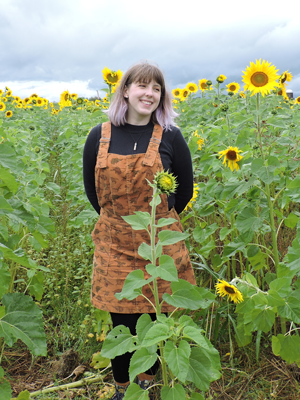 Emily Keeble (she/her)
Emily Keeble (she/her)
Vertebrate paleontology PhD student, Virginia Tech
My research involves quantifying the shape of teeth of Late Triassic reptiles (many of which are found at Petrified Forest) to answer questions of diversity through time and community structure. My work may also help in the identification of isolated teeth.
This will be my second year at PEFO. I loved seeing the dramatic landscapes in the park – they’re unlike anything I’ve ever seen!
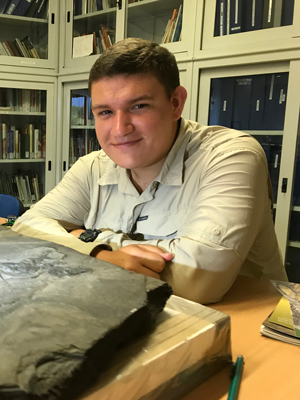 Isaac Pugh (he/him)
Isaac Pugh (he/him)
Geosciences graduate student, Virginia Tech
My research investigates how ecosystems and vertebrate diversity shift across time, with a focus on the reptiles common at Petrified Forest.
This will be my first field season at Petrified Forest, but I am excited to visit the sites that have been recently collected. Many of our lab specimens are the best preserved of their kind I have seen, so I am itching to get to the field to see where they come from and dig up a few more. I’m certain there is a specimen out there waiting for me to nickname it Jimmy.
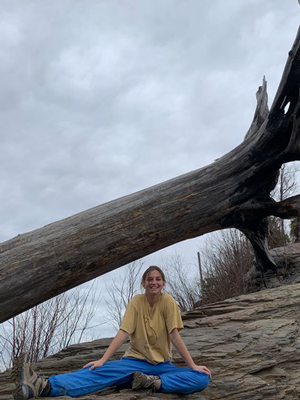 Helen Burch (she/her)
Helen Burch (she/her)
Geosciences PhD student (vertebrate paleontology focus), Virginia Tech
My research focuses on the composition of ancient animal communities. I am interested in learning how communities in deep time compare to those we know today, and to see what kind of patterns we can find in the fossil record. The Petrified Forest contains amazing fossils including sites filled with microvertebrates, or tiny fossils from a variety of ancient animals that can give us an awesome picture of what this ecosystem used to look like.
This will be my first summer at PEFO, and I am looking forward to getting hands-on experience identifying fossils in the field and learning specifics of the anatomy of these ancient animals. I am also excited to spend time in nature with my lab-mates, especially in a beautiful place with such a rich ecological history.
